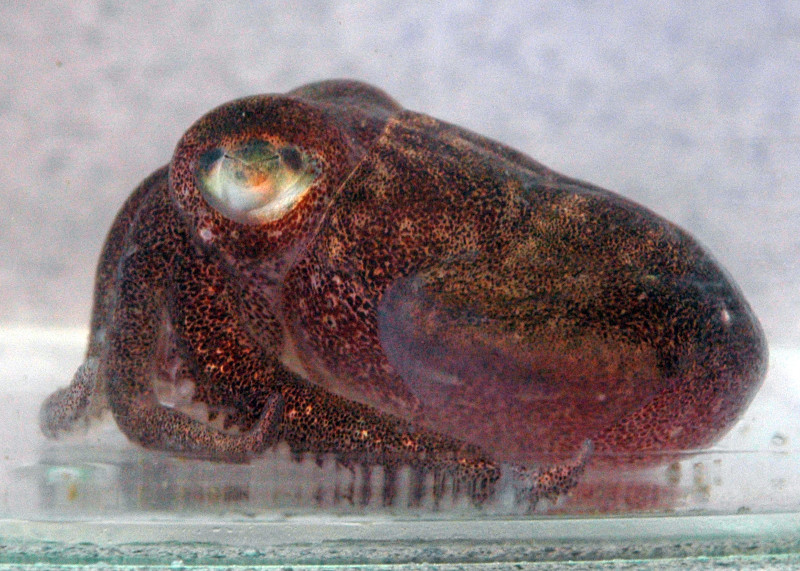
Stubby Squid Facts
- This remarkable creation of Nature and evolution most freuently goes by the somewhat amusing common name of the Stubby Squid. Yet, it also possesses a few other general titles. These options include the terms North Pacific Bobtail Squid and Pacific bob-tailed squid.
- Inside of the scientific community, however, it’s perhaps better known by its technical designation. Fortunately for the layperson, that’s an extremely easy to pronounce epithet compared to most. That’s because it currently holds the formal tag of Rossia pacifica.
- The amazing cephalopod received that official moniker due to the efforts of Samuel Stillman Berry. This respected American marine zoologist accomplished the first recognition of it as a separate and distinct species. He managed that scientifically noteworthy feat in the year 1911.
- This marvel of Nature and evolution garners interest among researchers for a variety of reasons. Among those is the fact that scientists currently acknowledge two separate subspecies. It’s entirely possible, though, that ongoing research may discover others in the future.
- For the moment, data on the population and relatively density of this for the Stubby Squid continues to be scarce. The IUCN therefore understandably currently lists the creature as Data Deficient. That status is reflected on the organization’s Red List of Threatened Species.
- Despite this degree of uncertainty, it’s reasonable to assume that the biological wonder faces, at least, the same potential threats to its existence as all other life on this planet. Most of these perils stem from the actions of man, including the danger posed by climate change.
Related Articles
Striped Pyjama Squid
Stubby Squid Physical Description
The remarkable Stubby Squid fully earns its respect and appreciation from those few individuals fortunate enough to encounter it. Yet, it does not do so due to any impressive physical stature. That’s because, while Nature provided it many wonderful features, size doesn’t rank among them.
In that regard, the creature follows a pattern common to its numerous relatives across the globe. That’s in the fact that it displays a certain degree of the physiological characteristic of sexual dimorphism. In its specific case, this natural trait manifests itself in terms of physical dimensions.
More precisely, females of the species attain a greater overall average size than their counterparts. The total difference, however, remains relatively very minor. In general, the awesome animal only reaches a mantle length of only 2 in (5 cm). Arms included, it only reaches 4.3 in (11 cm).
Not being fused to the head, the mantle developed as somewhat flattened, but rounded near the back portion. On either side of this, though, two large, semi-circular fins, with wide bases, appear. Yet, the animal conspicuously lacks the large bone here typical to most members of its Family.
It’s the head of the Stubby Squid that stands out the most in the minds of many, however. This body part hosts two greatly out-sized eyes. It also holds a pair of retractable tentacles. Not done there, evolution also placed eight arms here. Short in length, they serve as the source of the name.
As with most of its kindred, the coloring of the astounding creature’s skin varies at will. Typically, though, this primarily consists of a background of dark reddish-brown. Nonetheless, a scattering of small spots of yellow or brown also appear. Yet, this changes to a grayish-green in times of stress.
- Kingdom: Animalia
- Phylum: Mollusca
- Class: Cephalopoda
- Order: Sepiida
- Family: Sepiolidae
- Genus: Rossia
- Species: R. pacifica
Stubby Squid Distribution, Habitat, and Ecology
The intriguing Stubby Squid evolved as native to a moderately large expanse of the marine regions of the earth. Its indigenous zone of habitation consists of very specific sections of the Pacific Ocean, as its scientific name suggests. More precisely, it lives within the northern areas of that range.
One end of that approximate territorial reach extends from Japan and Korea, in Asia. From there, though, the cephalopod also appears in the waters of the Bering Sea. Yet, extending outward, its territory also reaches as far as California, on the west coast of the United States, in North America.
Evolution provided this marvel with a strong advantage over other, related species. That’s due to the fact that it displays a decidedly clear and strong flexibility regarding its choice of habitat depth, at least. It’s been seen at depths ranging from only 66 ft (20 m) to as great as 4,300 ft (1,311 m).
However, in all regions it does choose to live in, the marine animal displays the same precise patterns. The animal typically remains near the seafloor. This often includes regions of muddy sand, often with a sloping nature closer to shore. Amazingly, it’s even been spotted in polluted bay areas.
The aptly-named Stubby Squid lives a primarily solitary life. Due to this tendency, it’s rarely seen in groups, except for mating purposes. Like its relatives, it also developed as an entirely carnivorous species. It’s diet principally consists of shrimp. Yet, it also eats other prey, such as crabs and fish.
For breeding purposes, the animal usually moves out to deep water. That process generally occurs in either late summer and autumn. Having an average lifespan of roughly two years, both male and female typically die soon after mating. Females usually lay between twenty-five and thirty eggs.
Species Sharing Its Range
Dusky Dolphin
Check out our other articles on 5 Fabulous Animals of Cambodia, Cape Porcupine, Blood Falls, Snake’s Head Fritillary, Indian Bullfrog, Western Desert Tarantula, Great Potoo, Jamaican Iguana
